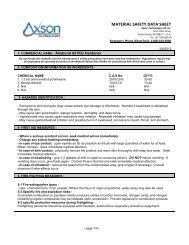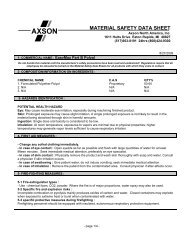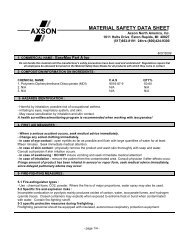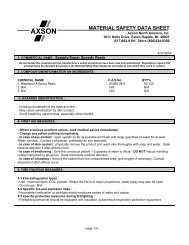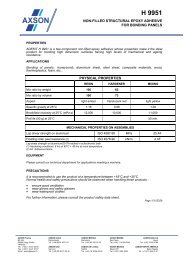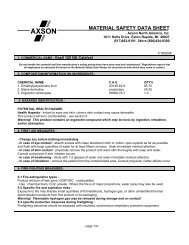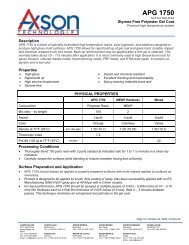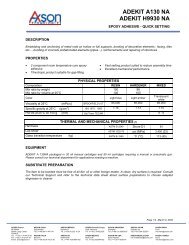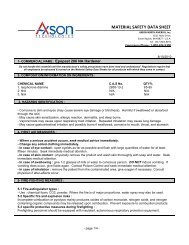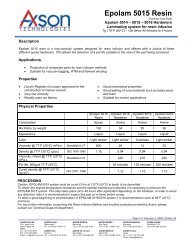Resin MSDS
Resin MSDS
Resin MSDS
You also want an ePaper? Increase the reach of your titles
YUMPU automatically turns print PDFs into web optimized ePapers that Google loves.
MATERIAL SAFETY DATA SHEETAxson Technologies US, Inc.1611 Hults Drive,Eaton Rapids, MI 48827 ‐ U.S.A.Tel. (517) 663‐8191Emergency Phone (ChemTrec): 1‐800‐424‐93001- COMMERCIAL NAME : APF 77/16/20/2012Do not handle this material until the manufacturer's safety precautions have been read and understood! Regulations require thatall employees be educated & trained on the Material Safety Data Sheets for all products with which they come in contact.2- COMPOSITION/INFORMATION ON INGREDIENTS :CHEMICAL NAME C.A.S QTY%1. Styrene 100-42-5 15-252. Unsaturated Polyester <strong>Resin</strong> Proprietary 25-353. Titanium Dioxide 13463-67-7 1-54. N/A N/A N/A3- HAZARDS IDENTIFICATION :Exposure Limits : (Styrene, Titanium Dioxide) - see section 15.Health Hazard : Irritant (Styrene) - Target Organs - eyes, skin, and respiratory tract.Fire Hazard : Flammable (Styrene) - Class 1c.Explosion Hazard : Hazardous (Styrene) - at elevated temperatures, such as fire.4- FIRST AID MEASURES :- Change any soiled clothing immediately.- In case of eye contact : open eyelids as far as possible and flush with large quantities of water for at leastfifteen minutes. Seek immediate medical attention.- In case of skin contact : physically remove the product and wash skin thoroughly with soap and water.Consult a physician if skin irritation occurs.- In case of swallowing : do not induce vomiting; seek immediate medical attention.- In case of inhalation : remove the patient from the contaminated area. Consult physician if after-affects occur.5- FIRE-FIGHTING MEASURES :5-1 Fire-extinguisher types :Use : chemical foam, CO2, powder, or any Class B extinguishing agent. Where the fire is of major proportions,water spray may also be used.5-2 Specific fire and explosion risks :Heat or contamination may cause hazardous polymerization. If polymerization takes place in closed container,there is a possibility of violent rupture of the container. Product vapors may form explosive mixture in the air.5-3 specific protective measures during firefighting :Firefighting personnel should be equipped with insulated, autonomous respiratory protection equipment.- page 1/4 -
COMMERCIAL NAME : APF 77/16/20/20126- ACCIDENTAL RELEASE MEASURES :6-1 Individual protection :Ventilation : General ventilation is required during normal use. Remove all sources of ignition.Respiratory protection : If PEL or TLV listed in this data sheet is exceeded, then suitable respiratory protectionmust be worn to prevent over-exposure.Protective gloves : Wear appropriate impervious gloves to prevent skin contact.Eye protection : Wear protective safety glasses with side-shields or face shield.Other protection : Wear appropriate clothing to prevent skin contact.6-2 Environmental protection : Please see § 126-3 Decontamination procedures :- Remove all sources of ignition and ventilate area.- Contain spilt material in order to avoid its transfer to sewers or rivers and streams.- Physically remove the material.- Cover product with sand, earth, or any other similar absorbent substance in order to soak up material. Theresulting mix may then be shoveled into containers and removed for proper disposal (see § 13).7- HANDLING AND STORAGE :7-1 Handling :- Remove all sources of ignition, open flame, and/or heat.- Avoid inhalation of dusts created during machining.- Inform personnel of risks associated with the product, the precautions to be taken and procedures to followwhere an accident occurs.- Observe personal hygiene rules to avoid contact with eyes and skin.- Avoid inhaling vapors produced by the material, especially when heated and/or sprayed.- Install showers and eye baths ("fountain" type).- Ensure sufficient ventilation, including appropriate local air extraction, in order to comply with workplaceexposure limits. Where vapors could escape into the air, local specific means of ventilation will be necessary.- Wash hands thoroughly at beginning of every work break and at the end of the working day.- Work stations and the general working area must be kept perfectly clean.- Avoid exposure to the material of persons having suffered from eczema or any other skin condition.7-2 Storage :- Keep the material hermetically sealed in its original packaging, protected from humidity and at a temperaturebetween 59 and 77°F / 15 and 25°C in a well-ventilated storage facility.- Ensure that the floor of the storage area is impermeable and concave to provide effective containment.- Keep the product away from food.- Reproduce labeling on all new packs where original packaging is divided.8- EXPOSURE CONTROLS/PERSONAL PROTECTION :8-1 Exposure controls : Always maintain airborne contaminates in the workplace at the lowest possible levels.8-2 Personal protection :- respiratory protection : NIOSH approved respirator, if needed (see § 15)- eye protection : YES, safety glasses with side shields or chemical splash goggles- skin protection : YES, protective gloves, such as nitrile, latex or rubberDo not mix work clothing and normal clothing. Wash hands thoroughly at beginning of every workbreak and at the end of each workday.6/20/2012- page 2/4 -
COMMERCIAL NAME : APF 77/19- PHYSICAL AND CHEMICAL PROPERTIES :Physical state : pasteColor : whiteOdor : strong, aromaticpH : not establishedFlash point : 89°F / 31°CVOC (g/l) : 128.55VOC (%) : 16.26Specific gravity : 1Solubility : - in water : at 68°F / 20°C : insoluble- in solvents : YES (soluble in many organic solvents : benzene hydrocarbons andchlorinated hydrocarbons, acetone, phthalates, methanol, ethanol, etc.)Self Accelerating Decomposition Temperature: >150°F (66°C)10- STABILITY AND REACTIVITY :10-1 Dangerous decomposition by-products :- These are non-existent if storage and handling rules are followed (please see also § 5-2).- Excessive heating over long periods causes product degradation and emission of irritating acrid fumes.10-2 Hazardous reactions with :- Exothermic (polymerization) reaction with strong acids and oxidizers.11- TOXICOLOGICAL INFORMATION :Primary route of entry : Inhalation and skin absorption.Effects on eyes : may be moderately irritating; causing pain, tearing, reddening, swelling and itching.Effects on skin : repeated or prolonged single exposure may cause irritation to the skin. May cause acutaneous allergic reaction in predisposed individuals. Styrene can penetrate the skin and cause systemiceffects similar to those identified under acute inhalation exposure.Effects of inhalation : may be irritating to the respiratory tract, may cause drowsiness, nausea, headache,fatigue, and dizziness.Effects on ingestion : causes irritation to the mouth, stomach tissue, and digestive tract. Vomiting may causeaspiration of the solvent resulting in chemical pneumonia.Toxicological Information : Possible carcinogen: Styrene - Class 2B12- ECOLOGICAL INFORMATION :Based on data for one or more similar products :Ecotoxicity : not establishedBiodegradability : yes13- DISPOSAL CONSIDERATIONS :Waste Disposal :If discarded, this material should be treated as Hazardous Waste based on the characteristic of ignitability(D001).Container Disposal :Empty containers may not be disposed of unless all remaining material adhering to the internal walls have beenremoved. Empty containers should be disposed of in accordance with all applicable laws and regulations.- page 3/4 -
COMMERCIAL NAME : APF 77/16/20/201214- TRANSPORT INFORMATION :DOT Regulations/Information : (check CFR 49 for exemption regulations)Proper Shipping Name: <strong>Resin</strong> SolutionHazard Class: 3 (Flammable)UN/NA Number: UN1866Packaging Group: IIIInternal label: H000502315- REGULATORY INFORMATION :US Federal Regulations :Toxic Substances Control Act (TSCA) :All components are included in the EPA Toxic Substances Control Act Chemical Substance Inventory.OSHA Hazard Communication Standards (CFR29) :Health (§1910.1200) - IrritantFire (§1910.1200) - Flammable; Class 1cExposure Limits (§1910.1000) :There are no established PEL's for the Polyester <strong>Resin</strong> in this productOSHA PEL for Styrene (100-42-5) is 50ppm for an 8-hr TLV. ACGIH TLV for Styrene is 20ppm.OSHA PEL Short Time Exposure Limit for a 15-minute period is 100ppm (no ceiling for brief exposure), howeverthe average for a single STEL period must not exceed 100ppm. ACGIH STEL for Styrene is 40ppm.OSHA TWA for Titanium Dioxide (13463-67-7) is 15 mg/m3 (respirable dust).ACGIH TLV is 10 mg/m3 (respirable dust).EPA SARA Title III :Section 302 - Extremely Hazardous Chemicals: noneSection 311/312 - Hazard Categories: immediate Health hazard, delayed health hazard, fire hazardSection 313 - Toxic Chemicals: Styrene (CAS 100-42-5) 15-25% CERCLA RQ: 1,000 lbs.You may be required to submit this <strong>MSDS</strong> to state and local emergency response agencies (SERC & LEPC) and to your local firedepartment based on the chemical and quantity stored at your location. Call the EPA Hotline @ (800)535-0202 for more informationor further assistance with chemical reporting requirements.16- OTHER INFORMATION :HMIS Ratings: Ratings Key: 4 = Highest hazard, 0 = Lowest hazard, * = Chronic Health HazardHealth 2*Fire 2Reactivity 1REVEALING MODIFICATION : stytdpdfRevised : 6/20/2012 Supersedes sheet : 2/9/2010 This sheet provides a complement to the product use instructions but does not replacethem. The information it contains is based on our current knowledge of the product concerned at the date of drafting. That information isgiven in good faith and does not in any circumstances remove from the user his duty to be aware of and to follow all legal regulations andstatutes covering his activities. The user takes sole responsibility for application of safety measures covering the use of the product he isaware of. We also draw the user's attention to the risks attached to any use of the product for applications for which it was not designed.6/2012 Form: GBStyreneTitanium PDF Axson Technologies- page 4/4 -



